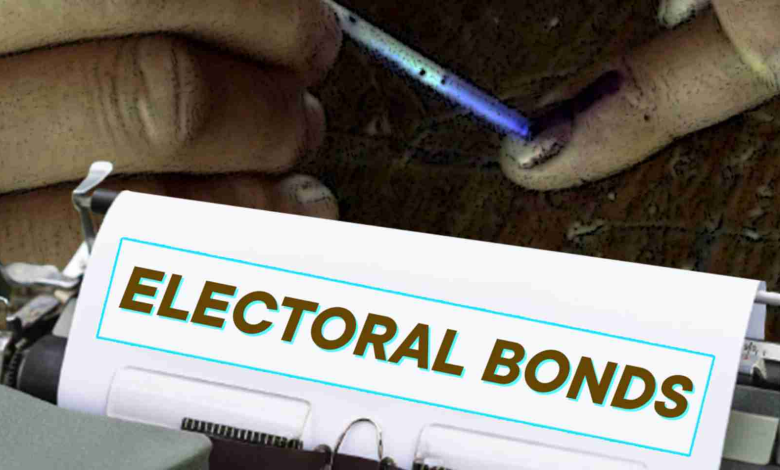Daily Current Affairs for UPSC
Electoral Bonds
Syllabus- Government Policies & Interventions [GS Paper-2]

Context- The 26th tranche of electoral bond sales was announced by the government and these sales will take place at all authorized State Bank of India branches over a ten-day period beginning on April 3 and ending on April 12.
Key Highlights
- Since the electoral bond scheme was introduced in January 2018 as a means of “purifying the system of political funding in the country,” a ten-day sale window in April is included in the stated schedule of sale of such bonds.
- According to the first plan, the bonds are made accessible for 10 days each in January, April, July and October, on dates determined by the Focal government, and 30 extra day time span in the extended period of the Lok Sabha races.
- The scheme was modified in November to grant the Centre the authority to declare an additional fortnight of electoral bond sales.
- Individuals can purchase electoral bonds on their own or with the help of others and send the funds to registered political parties that receive at least one percent of the vote in the Lok Sabha or Vidhan Sabha elections.
About Electoral Bonds
- The Electoral Bond Scheme, which was first announced on January 29, 2018, was included in the Finance Bill of 2017.
- An Electoral Bond is similar to a promissory note and can be purchased by an Indian citizen or an Indian corporation.
- Electoral Bonds can be purchased by a single individual or a group of individuals.
- Similar to banknotes, the bonds are interest-free and payable to the bearer upon demand.
- The Electoral Bonds can only be obtained by Political Parties that have been registered under Section 29A of the Representation of the People Act (RPA), 1951 (43 of 1951) and have received at least one percent of the votes cast in the most recent General Election to either the House of the People or the Legislative Assembly of the State.
Procedure
- The 29 authorized branches of the State Bank of India (SBI) are authorized to issue and cash Electoral Bonds.
- The bonds are sold by the SBI in divisions of Rs 1,000, Rs 10,000, Rs 1 lakh, Rs 10 lakh and Rs 1 crore.
- These bonds can only be purchased digitally or through checks.
- A bank account with the Authorized Bank is required in order for an eligible political party to redeem the Electoral Bonds.
- An eligible political party’s Electoral Bond deposit is credited the same day to its account.
- If the Electoral Bond is deposited after the expiration of the validity period, no payment will be made to any payee Political Party. Electoral Bonds are valid for fifteen calendar days from the date of issue.
Advantages of Electoral Bonds:
- Greater Transparency- It helps the political parties work with the election commission, regulatory agencies, and the general public in a more open way.
- Guarantees Responsibility– Only the party bank account listed with the ECI will be credited with donations made through electoral bonds. Every political party will be required to provide an explanation of how the total amount of money received has been spent because all donations will be encashed through banking channels.
- Eliminating Cash– Only a small number of notified banks, as well as checks and digital payments, will be accepted for the purchase. There will be no support for cash.
- Maintains Privacy– Donations made through electoral bonds can be made by individuals, groups of people, NGOs, religious trusts, and other trusts without disclosing their identities. In this way, the character of the giver is being protected.
Challenges for Electoral Bonds
- Hindering Right to Know: Voters will not be aware of which party has received funding and in what amounts from which individual, business, or organization. Before electoral bonds were introduced, political parties were required to disclose the names of all donors who had contributed more than Rs 20,000. The change violates the “Right to Know” of citizens and makes the political class even more unreliable.
- Low-level anonymity: The current government is not protected by anonymity because it always has access to donor information by requesting it from the State Bank of India (SBI). This suggests that taxpayers are the only ones who are unaware of where these donations came from.
- Unapproved Gifts: It is impossible to determine whether a political party has violated Section 29B of the RPA, 1951, which prohibits political parties from accepting donations from government companies and foreign sources, if the contribution received through electoral bonds is not reported. As a result, it is impossible to determine whether the political party has taken any donations.
- Towards crooked capitalism: It could turn into a helpful channel for organizations to full circle their money stopped in duty sanctuaries to ideological groups for some help or benefit conceded in kind for something. Black money could be introduced as a result of anonymous funding.
- Loopholes: Due to the fact that they may be required to disclose the amount donated to the Registrar of Companies, corporate entities may not benefit from transparency. The 7.5% cap on company donations is removed by electoral bonds, allowing even loss-making businesses to make unlimited donations and other contributions.
Supreme Court’s Stance on Electoral Bonds
- The Supreme Court (SC) agreed that the scheme hides the identity of buyers of electoral bonds, but emphasized that these transactions only took place through standard banking channels.
- In 2019, the Supreme Court ordered all political parties to provide the ECI with information about donations made through electoral bonds. Additionally, it requested that the window for purchasing electoral bonds be reduced from ten days to five days by the Finance Ministry.
- In addition, the Election Commission of India (ECI) informed the Supreme Court of India that, despite its support for the Electoral Bonds Scheme, it was against anonymous contributions to political parties.





.png)



